多媒体技术原理 视频中的基本概念
多媒体技术的基本概念、特点与应用
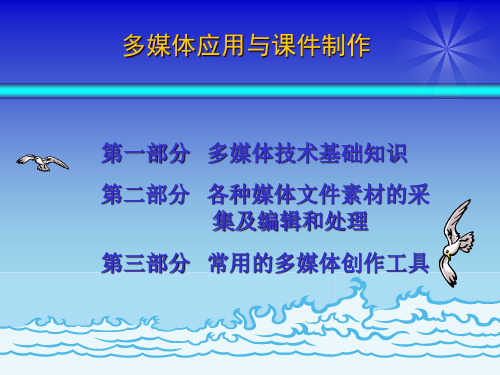
§1.4 多 媒 体 技术的应用
20世纪90年代以来,多媒体技术在教育培 训、电子出版物、娱乐游戏、网络通信、信 息查询、产品展示、广告宣传等方面得到广 泛应用,它正在改变着人类的学习、工作方 法和生活方式。
1. 4. 1 教育教学
1. 4. 2电子出版物
电子出版物一般使用CD-ROM光盘、互联网 作为载体,它图文并茂、有声有色,而且信息 量巨大,一张容量为650MB的光盘可以存储过 去20年“人民日报”的全部内容。
1)集成性 一方面是媒体信息的集成,即文字、声音、图形、图像 、视频等的集成;另一方面是显示或表现媒体设备的集 成。
2)数字化 数字化指多媒体系统中的各种媒体信息都以数字形式存 储在计算机中。
§ 1.2多媒体技术的特点
3)交互性 人可以通过多媒体计算机系统对多媒体信息进 行加工、处理并控制多媒体信息的输入、输出 和播放。简单的交互对象是数据流,较复杂的 交互对象是多样化的信息,如文字、图像、动 画以及语言等。
1、对硬件的要求较高,如高速CPU,大容量 的硬盘与内存,、高性能的声卡、显卡与显示 器等MPC中还必须安装各种多媒体软件,如数 字、文字、图像、声音和视频处理软件等 2、对各种多媒体信息的采集、处理、存储、 传输和显示全部实现了数字化。 3、具有人机之间的交互功能,可以非常灵活 地调用、处理和显示各种多媒体资源。
此外,它还具有检索方便、成本低廉、便于保 存、售价便宜等优点
浏览 ( /book/), 阅 读 一 部中国古典名著
1. 4. 3家庭娱乐
多媒体技术使普通的计算机变成了一个多功能 的交互式娱乐平台。利用多媒体计算机,可听 音乐、看电影、唱卡拉OK、玩电子弃,也可 以自己制作配乐诗朗诵、演示文稿、个人网站 等多媒体作品。
多媒体技术的基本概念
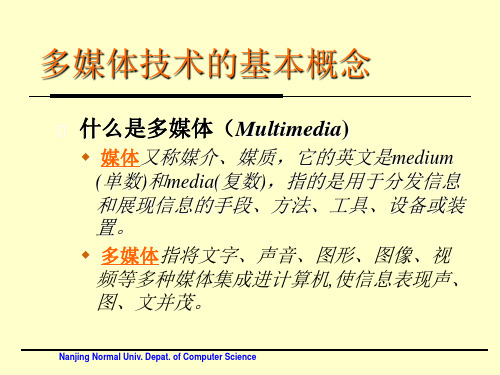
视频信息的表示与处理
视频信息(Video):运动图像(如25帧/秒) 视频信息的处理是多媒体技术的核心 计算机要处理视频信息必须将其数字化 数字化过程
采样 量化 编码压缩
Nanjing Normal Univ. Depat. of Computer Science
音乐符号化的一种方法 数据量少 易于编辑、修改 适用于表示各种乐曲演奏的音乐 尚不能表示声音
Nanjing Normal Univ. Depat. of Computer Science
声音录制与播放的处理过程
Nanjing Normal Univ. Depat. of Computer Science
多媒体技术的特点
多媒体技术强调的是交互式综合处理多种信息媒体 (感觉媒体)的技术。从本质上来说,它具有三种最 重要的特性:
多样性,使计算机所能处理的信息范围从传 统的数值、文字、静止图像扩展到声音和视 频信息;
集成性,即综合性,它能使多种不同形式的 信息综合地表现某个内容,取得更好的效果
交互性,使人们获取和使用信息变被动为主
视频信息数字化
数字化以一幅幅彩色画面为单位进行的 每个采样点分为亮度(Y)和色差(U、 V)三个分量
Nanjing Normal Univ. Depat. of Computer Science
几种常用数字视频格式
名称 分辨率 量化精度 数据量/秒
CCIR601 720X576X25 8+4+4
Nanjing Normal Univ. Depat. of Computer Science
多媒体技术的应用
多媒体技术的基本概念

1.2.2 数据压缩的编码方法
数据压缩的编码方法主要有以下几种: (1)预测编码 (2)变换编码 (3)量化 (4)熵编码 (5)具有运动补偿的帧间预测编码
华中师范大学计算机科学系
1.2.3 JPEG静态图像压缩编码
JPEG标准 JPEG目前成为数字图像压缩的国际标准。它用于连续 变化的静止图像,包括灰度等级和颜色两方面的连续变化。 JPEG包含两种基本压缩方法,各有不同的操作模式。第一 种是有损压缩,第二种为无损压缩,又称预测压缩
华中师范大学计算机科学系
1.4.2 多媒体终端的部件化、智能化
目前多媒体计算机硬件体系结构,多媒体计算机的 视频音频接口软件不断改进,尤其是采用了硬件体系 结构设计和软件、算法相结合的方案,使多媒体终端 设备具有更高的部件化和智能化,对多媒体终端增加 如文字的识别和输入、汉语语音的识别和输入、自然 语言理解和机器翻译、图形的识别和理解、机器人视 觉和计算机视觉等智能。 (1)专用芯片不断出新 (2)信息家电平台凸现 (3)嵌入式多媒体系统应用越来越广
华中师范大学计算机科学系
1.3 多媒体的应用领域
(1)文化教育领域 (2)历史研究领域 (3)多媒体在企业中的应用 (4)多媒体技术在体育教学中的辅助作用 (5)现代美术创作和电脑软件技术 (6)其他方面的应用
华中师范大学计算机科学系
1.4 多媒体的发展前景
21世纪技术的进步,特别是信息化步伐加快,数字 化技术将信息处理带入了新的领域。在信息技术飞速 发展的今天,计算机技术、网络技术多媒体技术的发 展与统一,无疑成为现代多媒体发展的新趋势。
1.1多媒体技术的基本概念
多媒体集文本、声音、图像、视频和动画等为一体, 是计算机处理信息多元化的技术和手段。多媒体技术 本质上是一种计算机接口技术,它采用图形交互界面、 窗口选择操作等,使人机交互能力增强,有利于人与 计算机之间的信息交流。
多媒体技术的概述

多媒体技术的概述随着科技的不断发展,多媒体技术在现代社会中扮演着越来越重要的角色。
多媒体技术通过将多种形式的媒体元素(文字、图像、音频、视频等)结合起来,为我们带来了丰富多样的视听体验。
本文将对多媒体技术进行概述,介绍其基本概念、应用领域以及未来的发展方向。
一、多媒体技术的基本概念多媒体技术是一种可以同时展示多种媒体内容的技术。
它不仅包括文字、图像、音频和视频等传统媒体形式,还可以将其融合和互动展示,创造出更加丰富的用户体验。
多媒体技术的基本原理是将不同媒体元素转换为数字信号,并通过计算机等设备进行存储、处理和传输,最终呈现给用户。
二、多媒体技术的应用领域多媒体技术在各个领域都得到了广泛的应用。
下面将分别介绍几个重要的领域。
1. 教育领域多媒体技术为教育提供了全新的方式和方法。
通过将教材转化为多媒体形式,教师可以通过图像、音频和视频等更加生动形象地展示知识点,提高学生的学习兴趣和理解能力。
同时,多媒体技术也为在线教育和远程教育提供了强大的支持,使学习可以跨越时空限制。
2. 娱乐领域多媒体技术在娱乐领域有着广泛的应用,例如电影、音乐、游戏等。
通过高清晰度的图像和逼真的音效,多媒体技术可以给用户带来身临其境的感觉。
此外,虚拟现实技术的发展也为娱乐领域带来了更加沉浸式的体验,使用户可以参与到虚拟世界中。
3. 广告和营销领域多媒体技术在广告和营销领域中被广泛应用。
通过图像、音频和视频等形式,广告创意可以更加生动有趣地展现给受众,吸引他们的注意力。
而且,多媒体技术也为个性化推荐和精准营销提供了技术支持,可以根据用户的兴趣和行为进行定制化的广告投放。
三、多媒体技术的发展方向随着科技的不断进步,多媒体技术在未来将继续发展壮大。
以下是一些多媒体技术的研究方向和趋势。
1. 融合与互动未来的多媒体技术将更加注重不同媒体元素之间的融合与互动。
例如,虚拟现实技术和增强现实技术的发展将使用户可以与虚拟世界中的元素进行互动,增强体验的真实感。
多媒体技术原理和基本概念
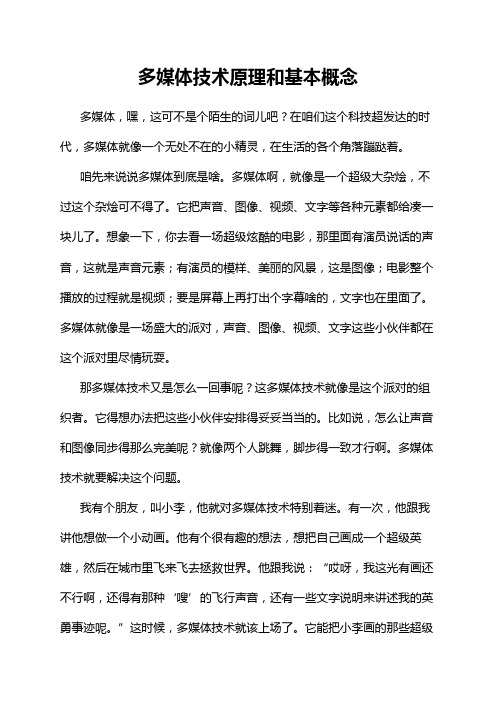
多媒体技术原理和基本概念多媒体,嘿,这可不是个陌生的词儿吧?在咱们这个科技超发达的时代,多媒体就像一个无处不在的小精灵,在生活的各个角落蹦跶着。
咱先来说说多媒体到底是啥。
多媒体啊,就像是一个超级大杂烩,不过这个杂烩可不得了。
它把声音、图像、视频、文字等各种元素都给凑一块儿了。
想象一下,你去看一场超级炫酷的电影,那里面有演员说话的声音,这就是声音元素;有演员的模样、美丽的风景,这是图像;电影整个播放的过程就是视频;要是屏幕上再打出个字幕啥的,文字也在里面了。
多媒体就像是一场盛大的派对,声音、图像、视频、文字这些小伙伴都在这个派对里尽情玩耍。
那多媒体技术又是怎么一回事呢?这多媒体技术就像是这个派对的组织者。
它得想办法把这些小伙伴安排得妥妥当当的。
比如说,怎么让声音和图像同步得那么完美呢?就像两个人跳舞,脚步得一致才行啊。
多媒体技术就要解决这个问题。
我有个朋友,叫小李,他就对多媒体技术特别着迷。
有一次,他跟我讲他想做一个小动画。
他有个很有趣的想法,想把自己画成一个超级英雄,然后在城市里飞来飞去拯救世界。
他跟我说:“哎呀,我这光有画还不行啊,还得有那种‘嗖’的飞行声音,还有一些文字说明来讲述我的英勇事迹呢。
”这时候,多媒体技术就该上场了。
它能把小李画的那些超级英雄的图像,按照一定的顺序排列好,再配上合适的声音,最后加上文字,就变成了一个超酷的小动画。
多媒体技术里有个很重要的部分,就是数据压缩。
为啥要数据压缩呢?你想啊,那些高清的视频、超清晰的图片,它们的数据量可大了。
就像你要把一堆超级大个儿的行李塞到一个小箱子里,得有个巧妙的办法才行。
数据压缩就是这个巧妙的办法。
它就像一个神奇的魔术师,把那些庞大的数据变小,这样在存储和传输的时候就方便多了。
要是没有数据压缩,咱们的手机啊、电脑啊,得需要多大的存储空间才能放下那些多媒体文件啊?那不得天天喊着“空间不够啦”?还有多媒体的交互性。
这交互性可有趣了。
就好比你玩一个游戏,你按一下按钮,游戏里的角色就会做出相应的动作。
多媒体技术的基本概念

多媒体技术的基本概念随着技术的不断发展,多媒体技术正逐渐渗透到我们的生活中,已经成为了我们生活和工作中不可或缺的一部分。
多媒体技术的出现不仅改变了信息传播的方式,也对我们的学习、娱乐和工作带来了全新的体验。
本文将介绍多媒体技术的基本概念,包括其定义、发展历程、核心特点以及应用领域等方面。
一、多媒体技术的定义多媒体技术是指利用计算机技术和通信技术,将文字、图形、图像、声音、视频等多种信息媒体有机地结合在一起,共同构成一个完整的信息系统。
这些信息媒体可以相互交叉、交织、互动,形成一个丰富多彩的信息环境,为用户提供更加直观、生动、丰富的信息体验。
二、多媒体技术的发展历程多媒体技术的发展可以追溯到上世纪70年代末和80年代初。
当时,随着计算机技术和通信技术的蓬勃发展,人们开始探索如何将文字、图形、音频、视频等多种媒体信息结合在一起,以最大程度地丰富信息传播的形式和内容。
到了90年代,随着互联网的普及,多媒体技术得到了更广泛的应用,并逐渐成为主流技术。
如今,多媒体技术已经成为了信息时代不可或缺的一部分,广泛应用于教育、娱乐、广告、电影、游戏等诸多领域。
三、多媒体技术的核心特点多媒体技术有以下几个核心特点:1. 多元化媒体:多媒体技术包含多种媒体信息,包括文字、图形、图像、音频、视频等,这些媒体依靠计算机技术和通信技术进行整合和传播。
2. 交互性:多媒体技术可以实现用户与信息之间的双向交流和互动,用户可以根据自己的需求随时选择、操作和参与信息内容。
3. 综合性:多媒体技术能够将各种媒体信息有机地结合在一起,形成一个综合的信息系统,用户可以通过各种方式获取信息,提高信息的传达效果。
4. 实时性:多媒体技术可以实现信息的实时传输和处理,用户可以及时获取所需的信息,实现及时反馈和互动。
四、多媒体技术的应用领域多媒体技术已经在各个领域得到了广泛的应用,主要应用领域包括但不限于以下几个方面:1. 教育领域:多媒体技术在教育领域得到了广泛的应用,例如电子白板、网络课堂、教学视频等,为学生提供了更加直观、生动的学习体验。
多媒体应用开发与音视频技术教程
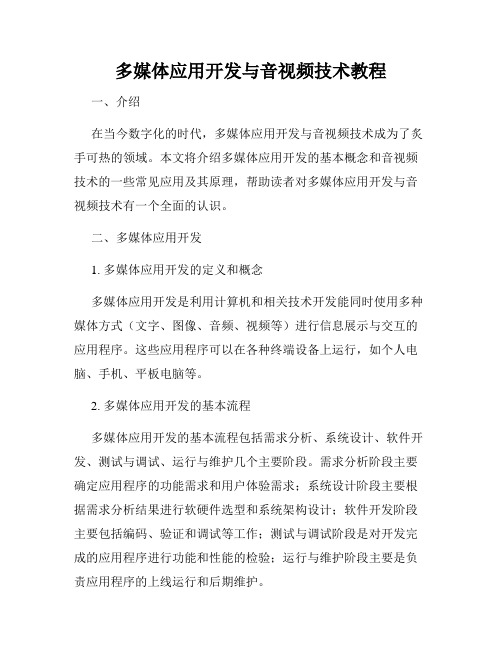
多媒体应用开发与音视频技术教程一、介绍在当今数字化的时代,多媒体应用开发与音视频技术成为了炙手可热的领域。
本文将介绍多媒体应用开发的基本概念和音视频技术的一些常见应用及其原理,帮助读者对多媒体应用开发与音视频技术有一个全面的认识。
二、多媒体应用开发1. 多媒体应用开发的定义和概念多媒体应用开发是利用计算机和相关技术开发能同时使用多种媒体方式(文字、图像、音频、视频等)进行信息展示与交互的应用程序。
这些应用程序可以在各种终端设备上运行,如个人电脑、手机、平板电脑等。
2. 多媒体应用开发的基本流程多媒体应用开发的基本流程包括需求分析、系统设计、软件开发、测试与调试、运行与维护几个主要阶段。
需求分析阶段主要确定应用程序的功能需求和用户体验需求;系统设计阶段主要根据需求分析结果进行软硬件选型和系统架构设计;软件开发阶段主要包括编码、验证和调试等工作;测试与调试阶段是对开发完成的应用程序进行功能和性能的检验;运行与维护阶段主要是负责应用程序的上线运行和后期维护。
三、音视频技术基础1. 音视频数据格式音视频数据格式包括了音频数据的编码格式(如MP3、AAC 等)和视频数据的编码格式(如MPEG-2、H.264等)。
这些编码格式旨在将音视频信号转换为数字信号以方便存储和传输。
2. 音视频编码原理音视频编码原理是将原始的音频或视频信号通过一定的算法进行压缩编码,以降低信号的数据量,从而实现高效的存储和传输。
这些算法包括数据压缩、信息重构和误差控制等。
四、音视频技术应用1. 视频会议系统视频会议系统是一种通过网络将多个位置分散的人员连接在一起进行远程视听会议的技术。
它利用音视频编解码技术和网络传输技术实现了远程实时通信和协作。
2. 视频监控系统视频监控系统是一种通过摄像机实时采集和传输视频信号,利用视频处理和存储技术进行监控和管理的系统。
它可以用于保护、安全监控和行为分析等领域。
3. 音视频娱乐应用音视频娱乐应用是指利用音视频技术实现的各种娱乐形式,如网络直播、在线电影、音乐播放器等。
多媒体技术的基本概念

多媒体技术的基本概念多媒体技术是指利用计算机技术对文字、图像、声音、视频等多种媒体进行综合处理和传输的技术。
它是信息技术领域的一个重要分支,涉及计算机图形学、计算机视觉、音频处理、视频处理、人机交互等多个领域。
随着计算机和网络技术的迅速发展,多媒体技术在各个领域都发挥着重要作用,包括娱乐、教育、医疗、广告、设计等。
多媒体技术的基本概念包括以下几个方面:一、多媒体技术的基本特点1.综合性:多媒体技术可以对文字、图像、声音、视频等多种媒体进行综合处理和展示,实现信息的多层次传达和沟通。
2.交互性:多媒体技术可以实现用户与系统之间的双向交互,用户可以通过多种方式对信息进行获取、处理和反馈。
3.实时性:多媒体技术可以实现实时的图像处理、音频处理和视频播放等功能,满足人们对实时信息的需求。
4.数字化:多媒体技术将各种媒体的信息数字化表示,便于计算机进行处理和传输。
5.集成性:多媒体技术可以将不同类型的媒体元素进行集成,实现丰富的展示效果和信息呈现方式。
二、多媒体技术的应用领域1.娱乐领域:多媒体技术在游戏、动画、影视制作等娱乐领域有着广泛的应用,可以为用户提供沉浸式的娱乐体验。
2.教育领域:多媒体技术可以为教学提供多样化的教学资源和教学方式,丰富课堂教学内容,提高学习效果。
3.医疗领域:多媒体技术可以应用在医疗影像诊断、手术模拟、远程医疗等方面,提高医疗服务水平。
4.广告与宣传领域:多媒体技术可以为广告和宣传提供丰富的表现形式和传播渠道,吸引受众的注意力。
5.设计与制造领域:多媒体技术可以应用在工业设计、虚拟现实、数字化制造等方面,提高产品设计和制造的效率。
三、多媒体技术的关键技术和方法1.图像处理技术:包括图像获取、图像处理、图像分析、图像压缩等技术,用于对图像进行处理和展示。
2.音频处理技术:包括声音的录制、混音、剪辑、压缩、回放等技术,用于对声音进行处理和播放。
3.视频处理技术:包括视频的采集、编码、解码、处理、播放等技术,用于对视频进行处理和展示。
什么是多媒体技术
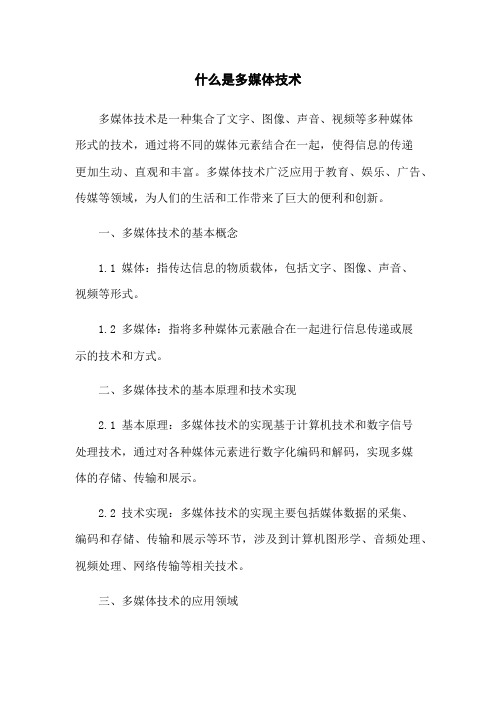
什么是多媒体技术多媒体技术是一种集合了文字、图像、声音、视频等多种媒体形式的技术,通过将不同的媒体元素结合在一起,使得信息的传递更加生动、直观和丰富。
多媒体技术广泛应用于教育、娱乐、广告、传媒等领域,为人们的生活和工作带来了巨大的便利和创新。
一、多媒体技术的基本概念1.1 媒体:指传达信息的物质载体,包括文字、图像、声音、视频等形式。
1.2 多媒体:指将多种媒体元素融合在一起进行信息传递或展示的技术和方式。
二、多媒体技术的基本原理和技术实现2.1 基本原理:多媒体技术的实现基于计算机技术和数字信号处理技术,通过对各种媒体元素进行数字化编码和解码,实现多媒体的存储、传输和展示。
2.2 技术实现:多媒体技术的实现主要包括媒体数据的采集、编码和存储、传输和展示等环节,涉及到计算机图形学、音频处理、视频处理、网络传输等相关技术。
三、多媒体技术的应用领域3.1 教育领域:多媒体技术在教育领域的应用非常广泛,可以通过图文并茂、声像并进的形式,提高学习效果,增强学习兴趣。
3.2 娱乐领域:多媒体技术在电影、电视、游戏等娱乐领域得到了广泛应用,提供了更加真实逼真、震撼人心的观影和游戏体验。
3.3 广告领域:多媒体技术在广告领域可以通过炫酷的视觉效果、动感的音乐和声音设计,吸引消费者的注意力,提升广告效果。
3.4 传媒领域:多媒体技术在传媒领域可以实现多渠道、多媒体形式的信息传递,为新闻报道、电视节目制作等提供丰富的表现手段。
四、多媒体技术的挑战和发展趋势4.1 挑战:随着技术的不断发展,多媒体技术面临着处理大规模数据、实时传输、跨平台兼容等挑战。
4.2 发展趋势:未来多媒体技术的发展将更加注重用户体验,提供更加个性化、智能化的媒体服务,同时与、虚拟现实等技术相结合,创造更加丰富多样的应用场景。
附件:本文档附带的相关附件包括多媒体技术的相关案例分析、技术实践指南等。
法律名词及注释:1、数字化版权管理(Digital Rights Management,DRM):是一种针对数字内容的版权保护技术,通过加密、授权和访问控制等手段,对数字内容进行保护和管理。
多媒体技术 第1章 多媒体技术概述
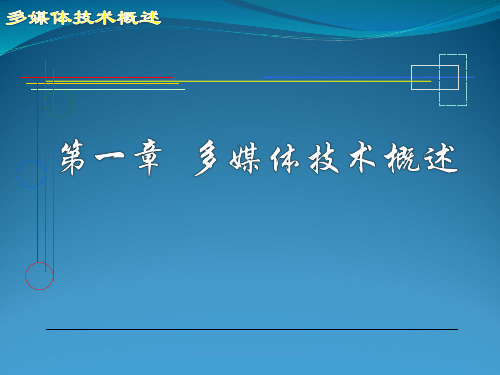
8 16
24
256 65536
16672216
256 色图像 HI-Color 图像
True Color 图像
多媒体技术概述 图像文件大小
用字节表示图像文件大小时,一幅未经压缩的数字 图像的数据量大小计算如下:
图像数据量大小 = 像素总数×图像深度(位)÷8
例如:一幅 640×480 的 256 色图像为 640×480×8/8 = 307200 字节
多媒体技术概述
音频
数字音频(Audio)可分为波形声音、语音和音乐。 − 波形声音包含了所有的声音形式,可以将任何声音进行 采样量化,相应的文件格式是WAV文件或VOC文件。 − 语音也是一种波形,和波形声音的文件格式相同。 − 音乐是符号化了的声音,乐谱可转变为符号媒体形式。 对应的文件格式是MID或CMF文件。
将文本、图形、图像、声音、动画、视频等多种媒体信 息,进行处理和集成,以供人机交互使用的一个计算机
应用分支。
课程性质
学习目标
学习方法
教与学
返回目录
多媒体技术概述
学 习 目 标
掌握多媒体技术的基本概念,认识和了解多媒体技术所涉及的 诸多应用领域,多媒体的发展方向和趋势。
了解多媒体硬件环境的构成、工作原理
在结构上存在冗余。 例如,布纹图像和草席图像。
− 图像的某个区域中存在 着非常强的纹理结构。
多媒体技术概述
1.2.1.2 数据压缩方法的分类
压缩处理由两个过程组成
− 编码过程,即将原始数据经过编码进行压缩,以便
存储与传输; − 解码过程,此过程对编码数据进行解码,还原为可
多媒体技术05-数字视频基本概念

内容随时间而变化,
伴随有与画面动作同步的声音(伴音),
人类接受的信息70%来自视觉, 其中活动图象是信息量最 丰富、直观、生动、具体的一种承载信息的媒体。
视频信息的处理是多媒体技术的核心。
2015-1-22
南京大学多媒体研究所
4
电视
电视是当代最有影响力的信息传播工具! 3种彩色电视制式:
6MHz 4.2MHz
音频
…
0.0 1.25 4.83 5.75 6.0
图象载波
6 MHz (NTSC)
2015-1-22
色度副载波
声音载波
南京大学多媒体研究所
19
(2)分量电视信号
为保证视频信号质量,近距离时可用分量视频信号
(component video signal)传输, 分量信号是指每个基色
575 625
(4/3)*575
模拟信号传输电视节目时的带宽:
PAL 制式是 8.0MHz(亮度信号为 5.5 MHz,2 个色度信号 均为1.8 MHz), NTSC制式是6.0MHz(亮度信号为4.2 MHz,2个色度信号 均为1.0 MHz)。
南京大学多媒体研究所 12
2015-1-22
易于编辑、修改等操作处理 用户接收的图像质量更好(可达演播室水平) 有利于存储,信息复制不会失真 有利于传输(抗干扰能力强)
节省频率资源(占用频道较窄)
可以通过公共电信网和计算机网传输 可以与其它媒体组合使用
ห้องสมุดไป่ตู้
可以生成描述信息(bits about bits),便于信息的检索和 使用
多媒体技术概论

多媒体技术概论引言多媒体技术是指将文字、图像、声音、视频等不同媒体形式结合起来,以提供丰富、多样化的用户体验的技术。
随着计算机和互联网的快速发展,多媒体技术的应用越来越广泛,涉及到众多领域,如娱乐、教育、医疗等。
本文将介绍多媒体技术的基本概念、应用领域和未来发展趋势。
基本概念多媒体的定义多媒体是指将不同形式的媒体内容(如文字、图像、声音、视频)以及交互功能(如点击、滑动)有机地结合在一起,通过计算机或其他电子设备进行展示和交流的技术和产品。
多媒体技术的要素多媒体技术主要由以下几个要素组成:1.文字:以语言文字的形式传递信息,是多媒体中的基本要素之一。
2.图像:通过静态的视觉元素传递信息和表达意义,可以是照片、图标、插画等。
3.声音:以声音的形式传递信息,可以是音乐、语音等。
4.视频:通过连续的图像序列传递信息,可以是电影、电视节目等。
5.交互功能:通过用户的操作和反馈实现用户和系统之间的互动。
多媒体技术的特点多媒体技术具有以下几个特点:1.综合性:多媒体技术可以将不同形式的媒体内容有机地结合在一起,提供更丰富、多样化的信息传递方式。
2.交互性:多媒体技术可以与用户进行实时的互动,用户可以通过点击、滑动等操作来控制和影响多媒体内容的展示和播放。
3.可视化:多媒体技术可以将抽象的信息转化为可视化的形式,提供更直观、易懂的呈现方式。
4.实时性:多媒体技术可以实时地呈现和处理媒体内容,使用户能够及时获取和分享信息。
应用领域多媒体技术的应用范围非常广泛,以下是几个常见的应用领域:娱乐多媒体技术在娱乐领域有着广泛的应用。
电影、电视、游戏等娱乐产品都大量使用了多媒体技术,以提供更丰富、更沉浸式的娱乐体验。
教育多媒体技术在教育领域起到了重要的作用。
通过多媒体教学,可以将抽象的概念变得更具体、更易懂,提高学习效果。
例如,通过图像、动画和声音结合的方式,可以帮助学生更好地理解和记忆知识点。
医疗多媒体技术在医疗领域也有着广泛的应用。
多媒体的基本概念与特点

多媒体的基本概念与特点多媒体是一种综合运用图像、声音、视频等多种媒介形式,通过计算机技术进行处理和传播的信息表达形式。
它将文字、图片、音频、视频等多种形式的信息集成到一起,以丰富、生动的方式呈现给用户。
多媒体在各个领域都得到广泛应用,如教育、娱乐、广告等。
本文将介绍多媒体的基本概念和特点。
一、多媒体的基本概念多媒体是一种综合运用多种媒介形式的信息表达方式。
它包括文本、图像、声音、视频等多种媒介形式的信息内容,通过计算机技术进行处理和呈现。
多媒体的基本概念由以下几个要素组成:1. 文本:多媒体中的文本信息是指通过文字表达的内容。
它可以包括标题、说明、描述等,为其他媒介形式提供补充和解释。
2. 图像:多媒体中的图像信息通过图片、插图等形式表达。
图像可以是静态的,如照片、绘画等,也可以是动态的,如动画、漫画等。
3. 声音:多媒体中的声音信息通过语音、音效等方式表达。
声音可以是语言的表达,如演讲、对话等,也可以是音乐、环境声等。
4. 视频:多媒体中的视频信息通过动态影像来表达。
视频信息可以是实景拍摄的影像、电影、电视节目等。
二、多媒体的特点多媒体具有以下几个特点,使其成为一种独特的信息表达方式:1. 交互性:多媒体可以通过用户的操作与之进行互动。
用户可以根据需要选择、播放、停止等操作,自由控制所呈现的媒体内容。
2. 多样性:多媒体融合了文字、图像、声音、视频等多种媒介形式,以及各种创意、表现形式。
它能够以多种形式和方式展示信息,丰富了信息传达的方式。
3. 生动性:多媒体通过图像、声音、视频等形式呈现信息,使得信息更加生动、直观。
通过生动的视听效果,可以更好地吸引用户的注意力,并加深对信息的理解与记忆。
4. 可视化:多媒体能够将抽象的概念以图像、声音等形式展示出来,使得复杂的信息更易于理解。
利用可视化的方式,多媒体可以将抽象的概念变得具体、形象,提高信息的传达效果。
5. 可复制性:多媒体可以通过数字化技术实现信息的复制和传播。
多媒体技术概论(1)

29.12.2020
37
三维交互设备
确定人体空间方向、位置、速度及施力大小。 数据手套 数据衣 数据头盔及眼镜 力反馈仪
29.12.2020
38
数据手套
数据手套跟踪手部运动 精确操作
5DT公司Glove 16型 传感器数据手套
29.12.2020
日本ATR实验室:筷子
39
数据头盔
数据头盔获得人头部的空间位置,并输出音 频和视频信号; 数据眼镜是图形图像输出设备。
29.12.2020
10
媒体与时间的关系
(1)独立于时间的媒体
这些媒体的信息由一组独立的元素组成,不 包含时间信息。这种媒体的处理应该尽可 能快,但这种处理不是限时的。
(2)依赖于时间的媒体
这些媒体信息不仅用一系列的值表示,而且
要指出相应值出现的时间。这些数据的处
理是限时的,数据的有效性依赖于时间条
29.12.2020
40
HMD
29.12.2020
41
Head-Mounted Displays
Two miniature display screens(LCD or CRT)
An optical system that channels the images from the screens to the eyes
Presenting a stereo view of a virtual world.
A motion tracker: continuously measures the position and orientation of the user's head and allows the image generating computer to adjust the scene representation to the current view.
多媒体技术知识点
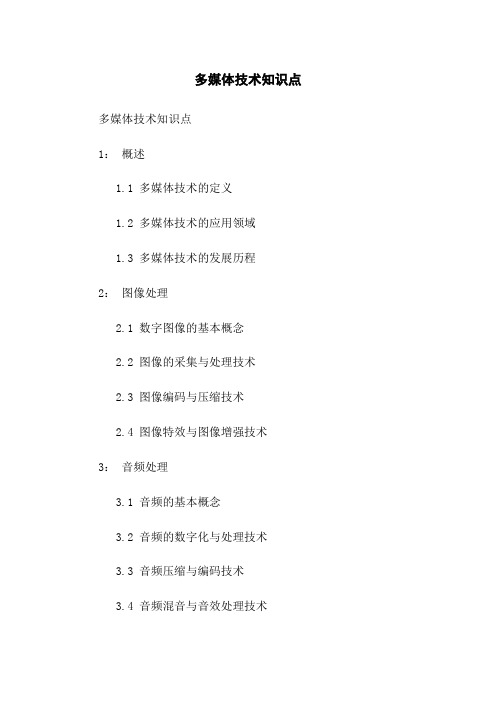
多媒体技术知识点多媒体技术知识点1:概述1.1 多媒体技术的定义1.2 多媒体技术的应用领域1.3 多媒体技术的发展历程2:图像处理2.1 数字图像的基本概念2.2 图像的采集与处理技术2.3 图像编码与压缩技术2.4 图像特效与图像增强技术3:音频处理3.1 音频的基本概念3.2 音频的数字化与处理技术3.3 音频压缩与编码技术3.4 音频混音与音效处理技术4:视频处理4.1 视频的基本概念4.2 视频的采集与处理技术4.3 视频编码与压缩技术4.4 视频特效与视频增强技术5:三维动画5.1 三维动画的基本原理5.2 三维建模技术5.3 光影与材质处理技术5.4 三维动画渲染与合成技术6:交互式多媒体技术6.1 交互式多媒体的基本概念6.2 用户界面设计技术6.3 交互式多媒体系统的开发技术 6.4 数据传输与网络通信技术7:多媒体应用开发7.1 多媒体应用开发的基本流程7.2 多媒体应用的平台选择与开发工具7.3 多媒体应用的系统设计与实现7.4 多媒体应用的测试与发布附件:附件1:图像处理的示例代码附件2:音频处理的案例研究附件3:视频处理的实践项目法律名词及注释:1:版权:指对创造性的作品享有的法律保护,包括文学、音乐、艺术、软件等作品。
2:数字版权管理:一种用于保护和管理数字内容的技术和方法,以防止未经授权的复制和分发。
3:数字水印:一种嵌入到数字内容中的可识别信息,旨在保护版权和追踪盗版行为。
4: DMCA:Digital Millennium Copyright Act的缩写,是美国一项法律,用于保护数字版权,并规定了有关侵权行为的责任和处罚。
多媒体的知识点总结

多媒体的知识点总结一、多媒体的基本概念1. 多媒体的定义多媒体是指利用计算机技术、图形处理技术、视频处理技术及通信技术等多种技术手段,将文字、图像、声音、视频等不同媒体形式集成到一个系统中,以实现信息的表达和传递。
2. 多媒体的特点(1)集成性:多种媒体形式可以通过技术手段集成到一个系统中,形成一个整体。
(2)交互性:用户可以通过多媒体系统实现与系统的互动,参与信息的表达和传递。
(3)实时性:多媒体系统可以实现对信息进行实时播放和处理。
(4)传输性:多媒体系统可以实现信息的跨平台和跨网络的传输。
(5)动态性:多媒体系统可以实现对信息的动态处理和显示。
3. 多媒体的应用领域多媒体技术广泛应用于教育、娱乐、广告、设计、制造、医疗等领域,如网络教学、数字图书馆、虚拟现实、数字娱乐、数字医学等。
二、多媒体技术的发展历程1. 多媒体技术的起源20世纪60年代,随着计算机和通信技术的发展,多媒体技术开始萌芽。
在1962年,鲁扎(Ivan Sutherland)研究的“隔离真空显示器(Sword of Damocles)”成为了首款可以实时创建和控制图像的电脑系统。
1970年,Intel公司推出了第一款感知器芯片(the first speck of a processor chip),它可以将数据转化为视频图像。
2. 多媒体技术的发展阶段(1)初级阶段:20世纪60年代到70年代,多媒体技术只能以孤立的方式存在,各媒体形式之间无法协调配合。
(2)中级阶段:20世纪80年代到90年代,随着计算机图形处理和视频处理技术的发展,多媒体技术开始逐渐具备了集成性和交互性。
(3)高级阶段:21世纪以后,随着网络技术和通信技术的快速发展,多媒体技术得到了进一步的拓展和应用,实现了跨平台和跨网络的传输。
3. 多媒体技术的关键技术(1)图像处理技术:包括图像采集、图像处理和图像压缩等。
(2)声音处理技术:包括声音采集、声音合成和声音压缩等。
多媒体技术的基本概念、特点与应用

多媒体技术的基本概念、特点与应用一、多媒体技术的基本概念多媒体技术是以计算机为中心,将文本、图形图像、音频、视频和动画等多种媒体信息通过计算机进行数字化综合处理,使多种媒体信息建立逻辑链接,并集成一个具有交互性的系统技术。
这里的“综合处理”主要是指对这些媒体信息的采集、压缩、存储、控制、编辑、变换、解压缩、播放和传输等。
在应用上,多媒体一般泛指多媒体技术。
二、多媒体技术的特点(1)多样性多样性是指媒体种类及其处理技术的多样化。
多媒体技术涉及多样化的信息,信息载体自然也随之多样化。
多种信息载体使信息在交换时有更灵活的方式和更广阔的自由空间。
多样性涵盖两个方面的内容:①信息媒体的多样化:多样化的信息载体包括磁盘、光盘、语音、图形、图像、视频、动画等。
②多媒体计算机在处理输入信息时,不仅仅是简单获取及再现信息,还能够根据人的构思和创意对文字、图形及动画等媒体信息进行交互、组合和加工,从而丰富艺术创造的表现力,以达到生动、灵活、自然的效果。
多样化不仅是指多种信息的输入,即信息的获取(Capture),而且还指信息的输出,即信息的表现(Representation)。
输入和输出并不一定相同。
若输入和输出相同,就称为记录或重放。
如果对输入进行了加工、组合与变换,则称为创作(Authoring),这样可以更好地表现信息,丰富其表现力,使用户更准确更生动地接收信息。
(2)集成性集成性即多种信息媒体的集成和处理这些媒体的软硬件技术及其设备和系统的集成。
在多媒体系统中,各种信息媒体是由多通道同时统一采集、存储与加工处理,更强调各种媒体之间的协同关系及对其所包含的大量信息的利用。
在硬件方面,多媒体硬件系统(包括能处理多媒体信息的高速及并行的CPU多通道的输入输出接口及外设、宽带通信网络接口及大容量的存储器等)将所有硬件设备集成为统一的系统。
在软件方面,则由多媒体操作系统来管理多媒体开发与制作的软件系统、高效的多媒体应用软件和创作工具软件等。
请分析多媒体技术的基本含义
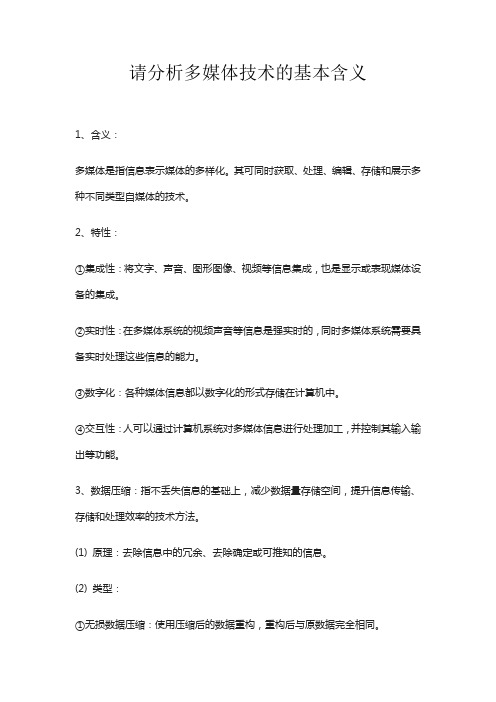
请分析多媒体技术的基本含义1、含义:多媒体是指信息表示媒体的多样化。
其可同时获取、处理、编辑、存储和展示多种不同类型自媒体的技术。
2、特性:①集成性:将文字、声音、图形图像、视频等信息集成,也是显示或表现媒体设备的集成。
②实时性:在多媒体系统的视频声音等信息是强实时的,同时多媒体系统需要具备实时处理这些信息的能力。
③数字化:各种媒体信息都以数字化的形式存储在计算机中。
④交互性:人可以通过计算机系统对多媒体信息进行处理加工,并控制其输入输出等功能。
3、数据压缩:指不丢失信息的基础上,减少数据量存储空间,提升信息传输、存储和处理效率的技术方法。
(1) 原理:去除信息中的冗余、去除确定或可推知的信息。
(2) 类型:①无损数据压缩:使用压缩后的数据重构,重构后与原数据完全相同。
②有损数据压缩:使用压缩后的数据重构,重构后与原数据有所不同。
但不影响原始数据信息的本质含义。
4、存储容量(1) 图片存储容量:存储容量(B) = 图像尺寸x 位深/ 8(2) 声音存储容量:存储容量(B) = (采样频率x 采样位数x 声道数x 时间) / 8(3) 视频存储容量:存储容量(B) = (画面尺寸x 色彩位数x 帧频x 时间) / 8真题:某视频参数属性如下,请计算其存储所需空间大小为()MB。
类型:flv视频编码:PLV1 每秒帧数18屏幕大小:640x840 宽高比自动比特率(KB/秒)512二次编码否答案:空间大小=比特率x时间(s)/1024=512x2x60/1024=60MB.真题:某照片部分属性如下。
一个有1G有效空间的U盘最多能存储该照片()张。
分辨率1024x1024宽度1024像素高度1024像素位深度24答案:图片文件大小=像素总量x颜色深度/8(字节)=1024x1024x24/8=3MB,已知该U盘空间为1G,所以可存储照片数量为,(1x1024)/3=341张。
多媒体技术的基本概念

多媒体技术的基本概念多媒体技术是指利用计算机等技术手段,将文字、图像、声音、视频等多种形式的信息进行集成和处理的技术。
它是信息技术和通信技术的交叉领域,是现代社会中广泛应用的一种技术手段。
多媒体技术的基本概念主要包括以下几个方面:1. 多媒体数据:多媒体技术的基础是多媒体数据,它包括文字、图像、声音、视频等多种形式的信息。
这些信息以数字化的方式存储和表示,可以通过计算机进行处理和传输。
2. 多媒体系统:多媒体系统是指由硬件和软件组成的一套完整的技术体系,用于实现多媒体数据的采集、处理、存储、传输和显示等功能。
它包括计算机、摄像头、麦克风、扬声器、显示器等硬件设备,以及操作系统、编码解码器、图形图像处理软件等软件组件。
3. 多媒体应用:多媒体技术可以应用于各个领域,如教育、娱乐、广告、医疗等。
在教育领域,多媒体技术可以通过图像、声音和视频等形式,提供生动直观的教学内容,提高学习效果。
在娱乐领域,多媒体技术可以实现丰富多样的游戏、影视作品等娱乐内容。
在广告领域,多媒体技术可以通过图像、声音和视频等形式,吸引人们的注意力,提高广告效果。
在医疗领域,多媒体技术可以实现医学影像的采集、处理和显示,帮助医生进行诊断和治疗。
4. 多媒体数据压缩:多媒体数据通常具有较大的存储和传输开销,为了减小数据量,提高存储和传输效率,需要对多媒体数据进行压缩。
常用的压缩方法包括有损压缩和无损压缩。
有损压缩是指在压缩过程中会丢失部分信息,从而降低数据量;无损压缩是指在压缩过程中不会丢失任何信息,但压缩比较低。
5. 多媒体数据传输:多媒体数据传输是指将多媒体数据从一个地方传输到另一个地方的过程。
传输过程中需要考虑带宽、延迟和丢包等因素对数据传输质量的影响。
常用的多媒体数据传输协议有TCP/IP协议和UDP协议。
TCP/IP协议可保证数据传输的可靠性,但延迟较大;UDP协议传输速度快,但不保证数据可靠性。
6. 多媒体数据处理:多媒体数据处理是指对多媒体数据进行编辑、合成、特效处理等操作。
- 1、下载文档前请自行甄别文档内容的完整性,平台不提供额外的编辑、内容补充、找答案等附加服务。
- 2、"仅部分预览"的文档,不可在线预览部分如存在完整性等问题,可反馈申请退款(可完整预览的文档不适用该条件!)。
- 3、如文档侵犯您的权益,请联系客服反馈,我们会尽快为您处理(人工客服工作时间:9:00-18:30)。
5.1 Types of Video Signals
• Component video – Higher-end video systems make use of three separate video signals for the red, green, and blue image planes – Each color channel is sent as a separate video signal.
S-Video — Two Signals
• S-Video – The reason for placing luminance into its own part of the signal is that black-and-white information is most crucial for visual perception. – In fact, humans are able to differentiate spatial resolution in grayscale images with a much higher acuity than for the color part of color images. – As a result, we can send less accurate color information than must be sent for intensity information — we can only see fairly large blobs of color, so it makes sense to send less color detail.
Composite Video — One Signal
• Composite video
– When connecting to TVs or VCRs, Composite Video uses only one wire and video color signals are mixed, not sent separately. The audio and sync signals are additions to this one signal. – Since color and intensity are wrapped into the same signal, some interference between the luminance and chrominance signals is inevitable.
Chapter 5 Fundamental Concepts in Video
5.1 5.2 5.3 5.4
Types of Video Signals Analog Video Digital Video Further Exploration
5.1 Types of Video Signals • Component video(分量视频) • Composite video(复合视频) • S-Video(超视频)
Composite Video — One Signal
• Composite video
S-Video — Two Signals
• S-Video – as a compromise, (separated video, or Supervideo, e.g., in S-VHS) uses two wires, one for luminance and another for a composite chrominance signal. – As a result, there is less crosstalk between the color information and the crucial grayscale information.
5.1 Types of Video Signals
• Component video
Composite Video — One Signal
• Composite video
– color (“chrominance”) and intensity (“luminance”) signals are mixed into a single carrier wave. – Chrominance is a composition of two color components (I and Q, or U and V). – In NTSC TV, e.g., I and Q are combined into a chroma signal, and a color subcarrier is then employed to put the chroma signal at the highfrequency end of the signal shared with the luminance signal. – The chrominance and luminance components can be separated at the receiver end and then the two color components can be further recovered.
